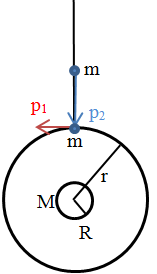Problem 1:
A particle of mass m moves in a central potential U(r) = kr2e-r/a,
with k and a positive constants.
(a) Write down the Lagrangian for this system and determine the second-order
equations of motion in polar coordinates.
(b) For what values of b is a circular orbit of radius b possible?
(c) For a circular orbit of radius a, write down the angular momentum M in
terms of m, k and a.
(d) Is a circular orbit of radius a a stable orbit?
Problem 2:
Stars often occur in pairs revolving around their common
center of mass. If one of the stars is a black hole, it is invisible. Explain
how the existence of such a black hole might be inferred from the light observed
from the other, visible star.
Problem 3:
 A satellite is in a circular orbit of radius r around an airless spherical planet of
radius R. An asteroid of equal mass falls radially towards the
planet, starting at zero velocity from a very large distance. The satellite and
the asteroid collide inelastically and stick together,
moving in a new orbit that just misses the planet's surface. What was the radius
r of the satellite's original circular orbit in terms of R?
A satellite is in a circular orbit of radius r around an airless spherical planet of
radius R. An asteroid of equal mass falls radially towards the
planet, starting at zero velocity from a very large distance. The satellite and
the asteroid collide inelastically and stick together,
moving in a new orbit that just misses the planet's surface. What was the radius
r of the satellite's original circular orbit in terms of R?
Problem 4:
Two particles with the same mass m orbit a massive planet of mass M >> m
and radius R. The orbit of one of the particles is circular, with radius
4R. The other particle's orbits in the same plane, but its orbit is
elliptical with semi-major axis 8R and rmin = 4R. The angular momenta of the two particles point in opposite directions. The particles
collide and stick together, forming a new object.
(a) What is the semi-major axis of the orbit of the new object in terms of R?
(b) Does the new object collide with the planet?
 A satellite is in a circular orbit of radius r around an airless spherical planet of
radius R. An asteroid of equal mass falls radially towards the
planet, starting at zero velocity from a very large distance. The satellite and
the asteroid collide inelastically and stick together,
moving in a new orbit that just misses the planet's surface. What was the radius
r of the satellite's original circular orbit in terms of R?
A satellite is in a circular orbit of radius r around an airless spherical planet of
radius R. An asteroid of equal mass falls radially towards the
planet, starting at zero velocity from a very large distance. The satellite and
the asteroid collide inelastically and stick together,
moving in a new orbit that just misses the planet's surface. What was the radius
r of the satellite's original circular orbit in terms of R?